Feature
Heat Exhaustion, Amputated Fingers, Crushed Limbs: The Hidden Cost of American Turkey
Food•8 min read
Solutions
At Gita Valley dairy, the cows are never slaughtered and the milk costs $18 a gallon.
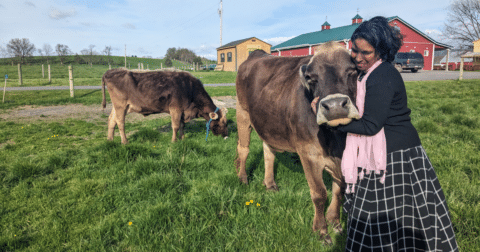

Words by Grace Hussain
“I’m never eating poop again,” exclaims Kunti’s daughter after learning how cow manure is used as fertilizer to grow food. Like me, it’s the young girl’s first time visiting Gita Valley, a farm Kunti has fond memories of visiting when she was about her daughter’s age. I’m spending the weekend at the farm, a non-profit that also serves as a sanctuary and ecolodge, tucked into the hills of rural Pennsylvania. The farm follows an Ahimsa model, refusing to slaughter their cattle. “Ahimsa” means “nonviolence” in Sanskrit and it’s often used by farms that do not slaughter or otherwise harm their animal residents. Though there are other ahimsa dairy farms, this is the first to be inspected and certified by the U.S. Department of Agriculture to be able to sell to the public. Gita Valley rescues cows at four or five years old, right around the time they’d be culled from a conventional dairy herd.
There’s definitely a market for their products, Dhruva tells Sentient. Like many followers of ISKCON, or the International Society of Krishna Consciousness, Dhruva and his wife, Parijata, or PJ, who run the farm, go by their spiritual names. At $18 a gallon, the market for Gita Valley milk is a small one. The majority of their customers are either Hindu or vegans who have decided to consume dairy, the same demographics that tend to visit the farm for retreats.
In the U.S., the average price for a gallon of milk is around $4 (for organic, it’s roughly twice that amount). It would be impossible to produce the quantity of milk and other dairy products that we currently consume in the U.S. following this model. The amount of cheap dairy and meat we consume in the U.S. is only possible thanks to the last several decades’ intensification of agriculture.
Kunti and her daughter are two of the six family members, spanning three generations, visiting the farm that weekend.. Though it’s been years since she’s been there, Salazar says the farm and sanctuary are special places for her. Now she wants her daughters to experience Gita Valley too, to meet the cattle and get dirty, two important parts of childhood, she says. “I think it’s important for kids to learn you’re not the center of the universe. You’re one more soul of many different types of souls,” she tells Sentient. “It kind of creates for them, at a young age, an identity that isn’t surrounded by like, centering themselves, but rather centering other people as well.”
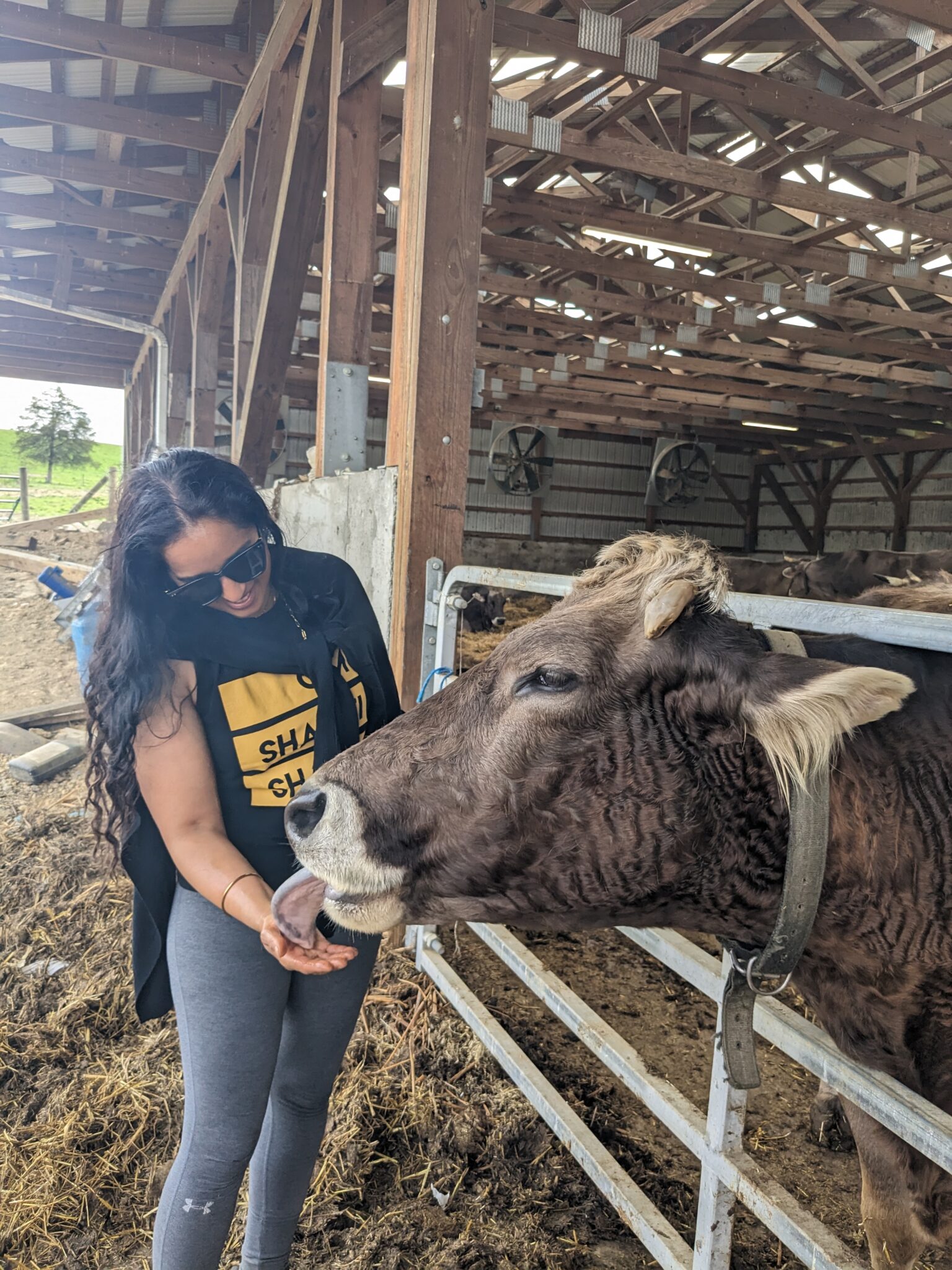
It’s not just their refusal to slaughter their cattle that sets Gita Valley apart. They also don’t breed their cows to stimulate milk production. On a typical, conventional dairy farm, PJ tells Sentient, “the sad part of it is that they might give a lot of milk, but they do it for a very short time. Then it plummets, because they get bred back each time. When they come to us, we try to not push them, and then we see there’s a steady, consistent level of giving for a longer time, other than a spike and then a dip,”.
Most dairies breed cows about once a year, to keep their milk production high. Gita Valley primarily rescues cows from conventional dairy farms who have recently calved and are producing milk, PJ tells Sentient. Instead of breeding them again the next year however, Gita Valley continues to milk them until their milk naturally dwindles, a process that can take years.
“The welfare is likely to be really good,” Phil Brooke, Welfare and Education Development Manager at Compassion in World Farming, tells Sentient. “The cow is given a life that they otherwise wouldn’t have. So I think that you could make a very good ethical case, even from a vegan abolitionist point of view.”
As an International Society for Krishna Consciousness (ISKCON) center, Gita Valley is home to one of the 55 temples dedicated to Krishna, a Hindu deity, in the United States. Every aspect of the farm’s operations is informed by the society’s philosophy — including how they care for the cows.
For followers of Krishna, cows are dear pets, almost family in the same way that many people keep and care for dogs or cats, says PJ. That’s why devotees are particularly fond of cattle, though they do their best to avoid causing harm to any living being. At least one resident, Dasya, says he go so far as to avoid standing on the grass unnecessarily.
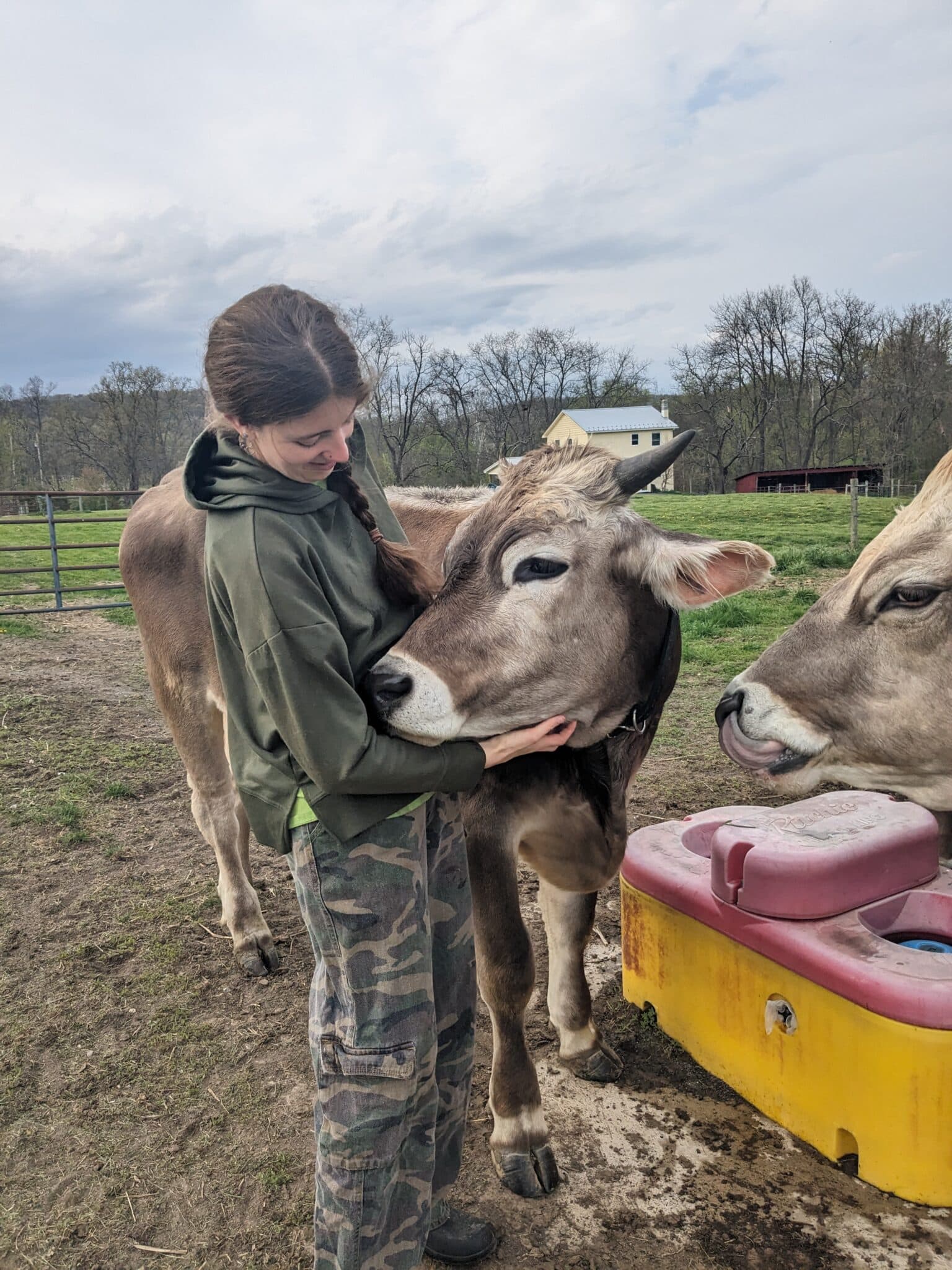
Their outlook on all living beings is driven by the soul that they believe all of us share, from blades of grass to cows and people, PJ says. It’s that part of the soul that translates between bodies via reincarnation, she says. In that way, all beings are connected.
The farm plays host to 16 human residents. Each of them work on a different project, with some working in administration while others are posted in the kitchen or the pastures. Many of the residents fill in gaps wherever they’re needed, some days milking cows and others cleaning and prepping the buildings for visitors. While some receive a small stipend, many of them are volunteers, driven by the society’s expectation of service.
The weekend that I visited the sanctuary marked the shift in season from winter to spring. The warmer weather brought with it freedom for the cows, who had been mostly confined to their barns during the frigid winter months. Every year people from around the community gather to watch the cattle as they’re brought out to pasture, an event they call “the spring dance.” As the cattle rush out of the barn and into the fields, they run and leap, stretching their legs and exploring their new surroundings. They also play — clashing horns and chasing each other around the field.
The horns are an easy way to identify which cattle were born at Gita Valley and which were rescued. The farm doesn’t remove their residents’ horns, a standard practice on conventional dairies. Another clear marker: ear tags. Cattle who were rescued still sport numbered tags punctured through their ears whereas the ears of cattle born on the farm are intact.
The first cows to be released to pasture are a group of younger cows and oxen — all the male cattle are neutered to prevent them from breeding as having large groups of bulls could be dangerous — who were born on the farm and have never been part of a production system. Over the next couple of days the other resident cattle are released to their respective pastures. Young oxen and their surrogate mothers, retired milking cows — who PJ affectionately calls ‘the mothers’ — older oxen and, finally, the milking cows. All of them react with the same excitement as the first group.
On several occasions the cattle prove hard to direct, as the farm doesn’t have dogs or vehicles to herd them in the correct direction. Instead, Dhruva chases them himself. Others try a different technique, calling to them. While choosing not to keep dogs or use ATVs to herd the cattle saves the herd some discomfort, that choice can also be time consuming. On Saturday evening as the sun dips behind the hills, the young oxen break free, running around the farm as people follow, attempting to steer their paths. Eventually, they settle into a pasture for the night before being moved to the intended pasture the next morning.
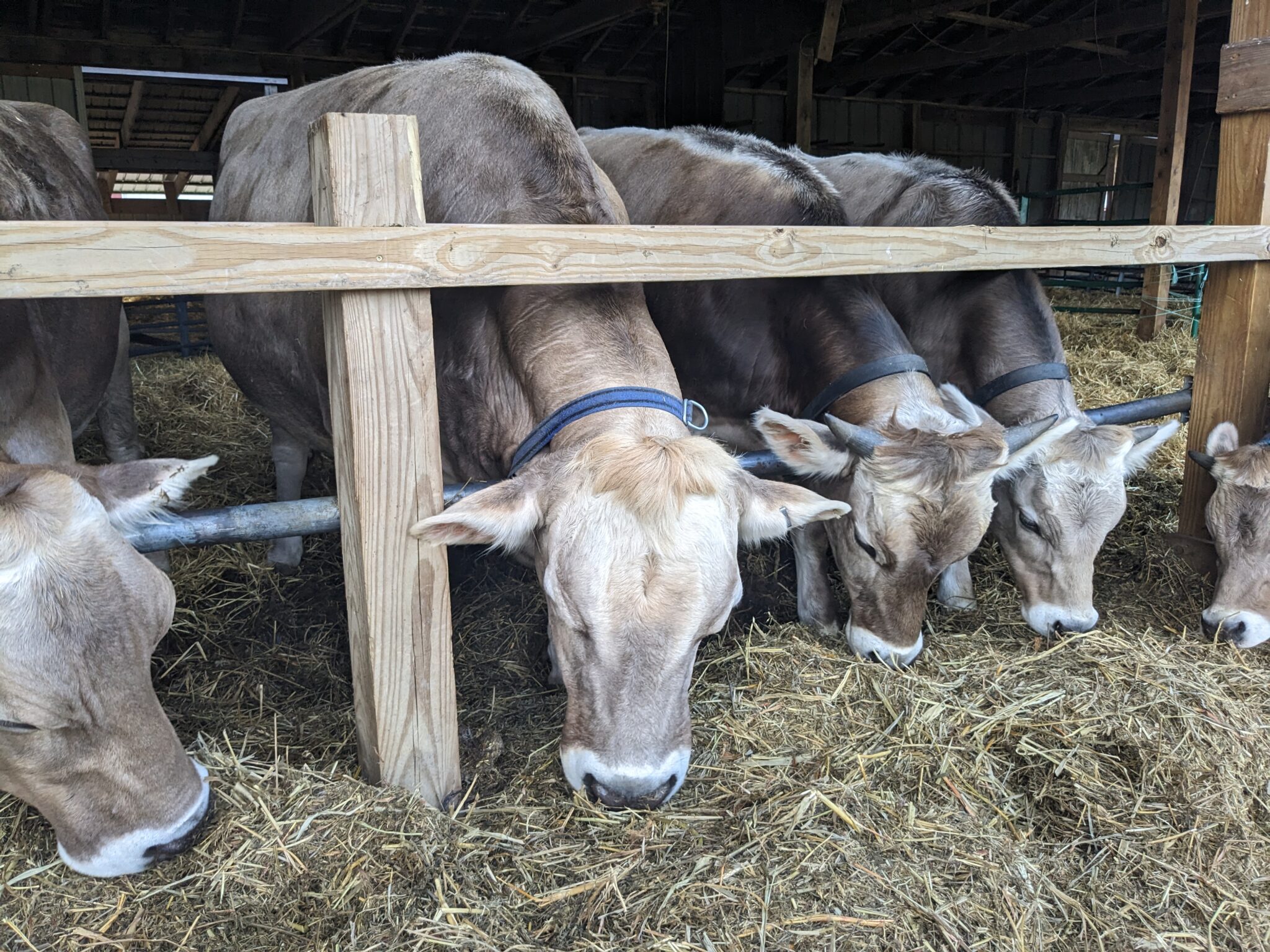
The cattle and residents aren’t the only ones who find sanctuary at Gita Valley, hundreds of visitors annually are renewed by the pastured hills and forests. The weekend I visited, the residents and surrounding community members were hard at work preparing for the retreat taking place the following weekend.
Cow cuddling, yoga and vegan food are all intrinsic parts of retreats. But perhaps one of the most important facets is the ability to connect with the land. “The rhythm of a farm is it’s, it’s slower, it starts earlier in the day and it ends earlier in the day,” says Salazar. She’s visiting from D.C., and the change of pace at the farm allows her anxiety to “melt away,” she says.
At Gita Valley, the land represents an important part of the system, making caring for it just as important as caring for its residents. They maintain a forestry plan that includes planting native trees in an effort to offset some of the carbon released by the cattle. Gita Valley has over 100 acres of forested land.
All of that forest also provides habitat for a variety of wild animals including deer, numerous birds, foxes and others. It’s a solution that wouldn’t work at a larger, intensive scale of production but rewilding can have biodiversity and carbon benefits.
The dairy portion of the farm is self-sustaining, says Dhruva. Each gallon of milk sells for $18. Compassion in World Farming’s Phil Brooke says it’s less than he would have expected given the lifelong care provided the cattle.
Right now, Gita Valley’s cows are only producing enough milk to satisfy their subscribers, who pick up milk weekly at the farm or at locations across many local cities, including Washington D.C. and Philadelphia.
When PJ and Dhruva’s predecessors were looking for land, proximity to major city centers was an important factor. On top of being a market for their milk and other dairy products, city residents also attend events or visit for the weekend.
“This is a space where the city dwellers get some respite from city life,” PJ tells Sentient. “Here for us, it’s production, which is producing food from the land: be it honey from the bees, maple from the trees, dairy from the cows, and then being able to supply all the residents with that, and then whatever is surplus then goes to the city projects.”
As a highly diversified operation, Gita Valley has multiple streams of income, but the most significant is their ecolodge, says Dhruva. It’s the lodge that allows them to pay many of their bills.
In addition to running the ecolodge and keeping the dairy herd, Gita Valley produces maple syrup and honey from the beehives they keep. Though the honey is not ahimsa, as some bees do sting the keeper and thus die during the production process, the hives are maintained through the winter. In conventional honey production, hives are culled when their production drops, typically over the winter months. Another difference between the two: conventional bee farms take the majority of honey from hives, replacing it with sugar water. At Gita Valley the honey is only collected from one of the hive boxes which the queen isn’t able to enter due to her size.
The farm also benefits from donations, both in-kind and monetary. When it comes to monetary donations, they often come with restrictions. Recently, Gita Valley revamped their website courtesy of a donor. While Dhruva had other projects in mind on the farm, the donor dogeared the money for the website, which needed work, says Dhruva. Still, he hopes the new site will draw more visitors to the farm.
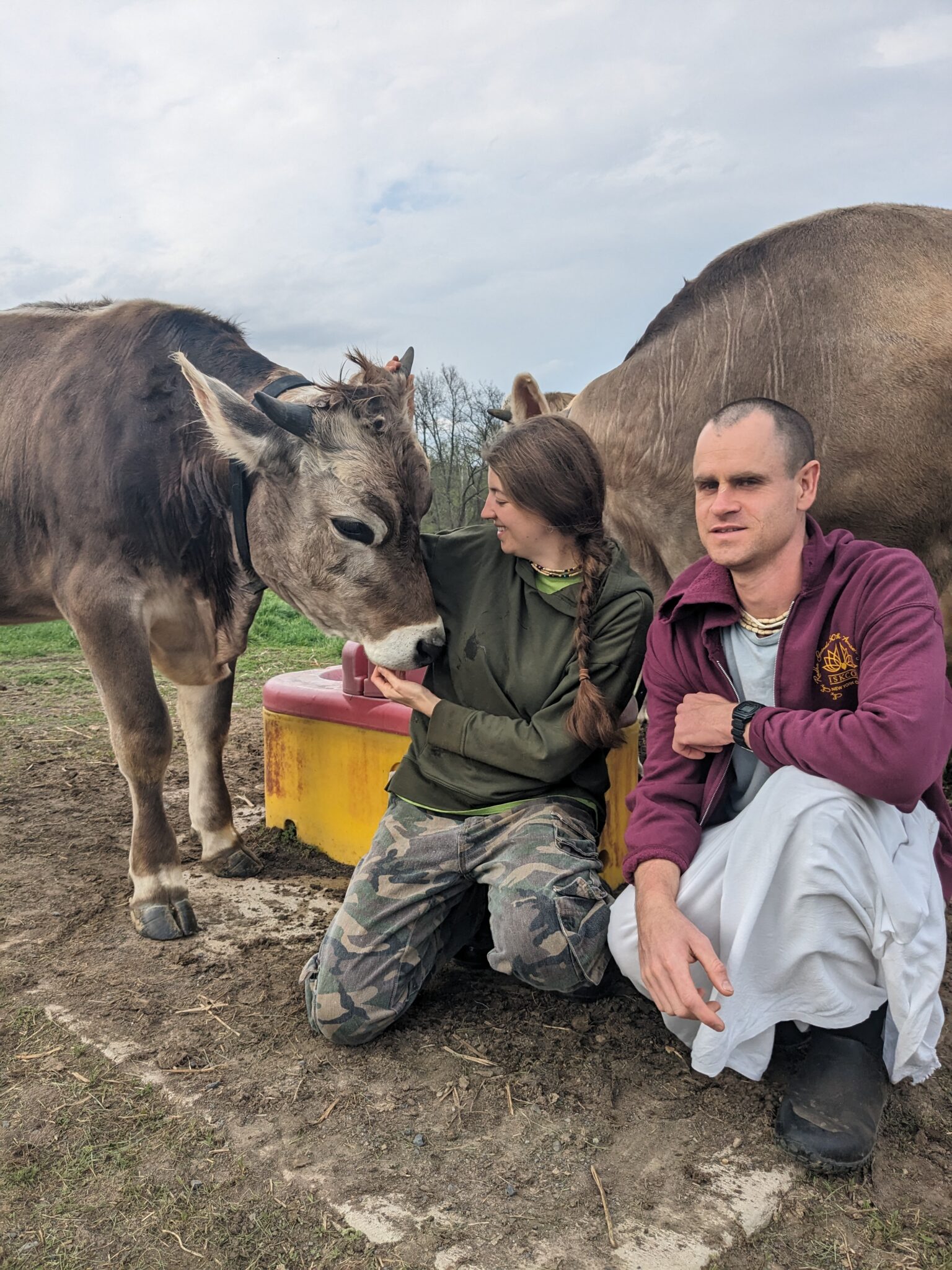
Many of the in-kind donations they get come in the form of food and clothing. Madhupan enjoys both, preparing the food and upcycling some of the clothing as new pieces or crafts. As the kitchen manager, she does the menu planning, working with a handful of others who trade off prep duties. Aside from yogurt with breakfast and the occasional use of honey from their bees or dairy products from their cows, the food served at Gita Valley is completely vegan.
During my visit, the kitchen team prepared fresh bagels and muffins in the morning, empanadas, salads, sushi and pasta for lunch. Dinner is a dish of leftovers taken from the lunch buffet and placed in the fridge for later.
At Gita Valley, the farm caps the herd size at 108, PJ says. They have decided to never add more than six cows a year. Adding six cows means three milking mothers and three calves. The farm prioritizes male calves to prevent them from being sold for veal. Typically, they only add cows to the herd when cows already in the herd “leave their bodies,” says PJ.
Because the cows are from conventional dairies where they are separated almost immediately after birth, the mother cow often doesn’t have the instinct to care for the calf, PJ tells me. That’s why they have two surrogate mothers who are older cows. They’re no longer giving milk but have exceptional maternal instincts. If the calf and their mother do have a relationship, then the two are left together.
A maximum of 20 cows get milked twice daily at Gita Valley. The rest of the cattle living on the farm are oxen, retired milking cows or heifers who have never been pregnant and do not give milk. “We don’t want to scale. We’d love to rescue every cow there is,” says PJ but they can’t do that because of the costs associated with caring for them for their entire lives.
The cows’ welfare is one of the farm’s biggest priorities. It’s also the reason why the dairy is not certified organic even though they follow all the organic practices. The only exception: they give their cows antibiotics for infections and don’t cull them from the herd. Organic certification prevents cows from getting any antibiotics, even if they’re sick. “We call ourselves beyond organic,” says PJ.
The only reason that they eat dairy at Gita Valley is that they produce it themselves in a way that doesn’t harm the cows. And still they only consume a small amount of it, mostly as yogurt in the mornings.
Abstaining from meat and conventionally produced dairy is part of living a life based in compassion instead of exploitation, says PJ, who describes the conventional food system as one based on “fear,” “harshness” and “oppression,” and even a belief that consumption of other species could be fueling other forms of exploitation happening in the world.
The lifestyle, says PJ, is grounded in asking “how do I live in harmony with all the rest of the planet in terms of the natural resources and the other species of life?” Once someone takes that perspective, she says “it will naturally soften them to live in harmony with other humans.”
Clarification: we changed “ethical vegans” to “vegans who have decided to consume dairy,” as the precise definition of vegan is beyond the scope of this piece.